Mediterranean cuisine originates in the regions surrounding the Mediterranean Sea, encompassing diverse cultures and culinary traditions. Characterized by the ample use of olive oil, vibrant fruits and vegetables, grains, and a variety of lean proteins, this cuisine gives us creamy hummus, fresh salads, hearty pasta, and fragrant spice-laden stews. The Mediterranean Diet, based on this cuisine, is globally recognized for promoting healthful and sustainable living, rightfully earning a spotlight in the health and wellness sector.
While it shares similarities across various cultures, the cuisine can be broadly classified into North African, Southern European, and Eastern Mediterranean. Each region imparts its unique flair – spices illuminate North African cuisine, herbs and wine dominate the Southern European palate, whereas the Eastern Mediterranean offers a delightful array of flavours from countries like Greece, Egypt, Israel, Syria, Lebanon, and Turkey. Bread is a common element across all regions, showcasing the creativity in Mediterranean cooking through a plethora of dishes made from this staple food.
10 popular Mediterranean dishes you must try
Here are 10 popular dishes packed with healthful ingredients and exuding flavours from herbs and spices native to the Mediterranean Basin –
1. Hummus
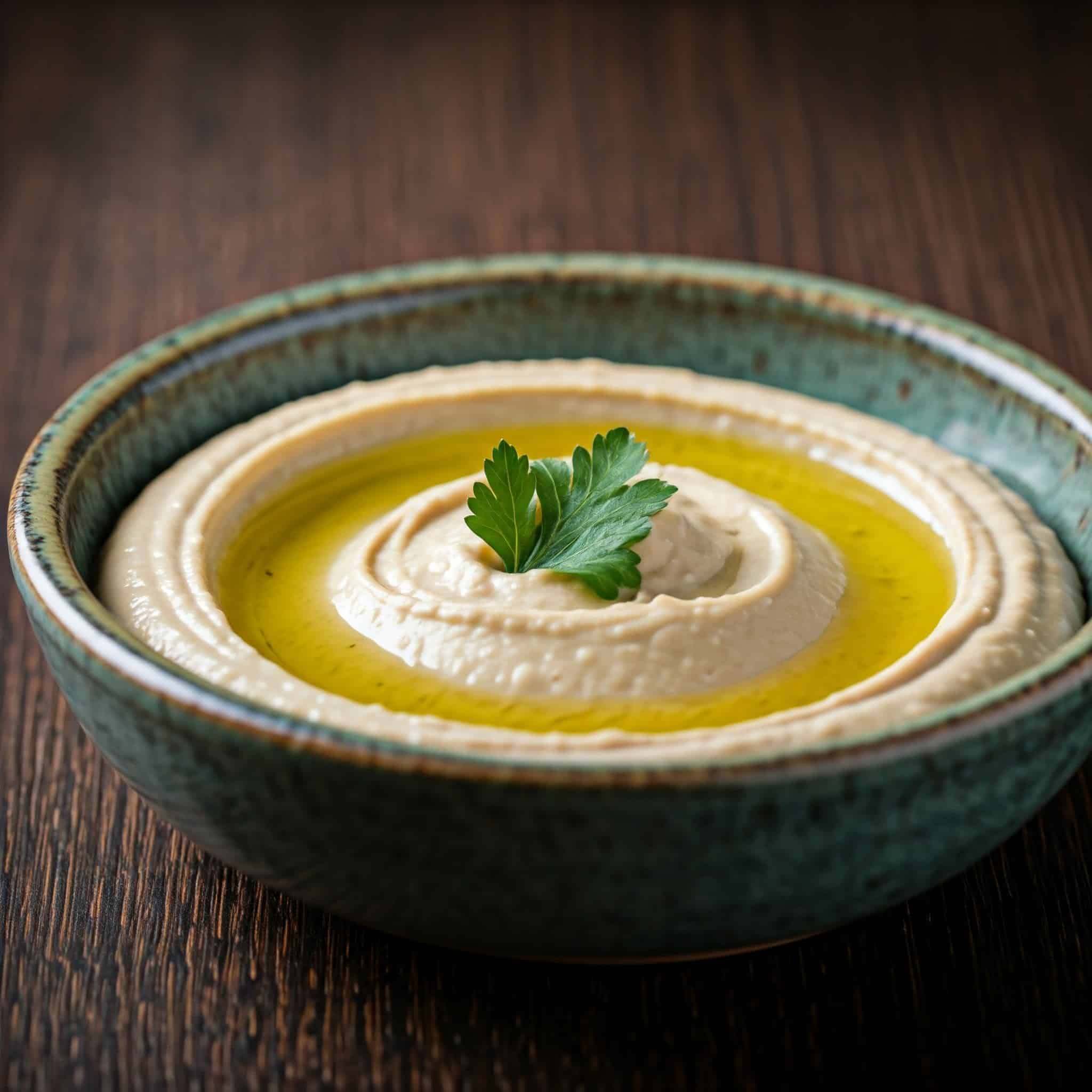
Hummus
Originating in the Middle East, hummus is a popular dish globally and is loved for its creamy texture and versatile flavour profile. It forms an integral part of Mediterranean cuisine, prepared by blending chickpeas with tahini, olive oil, and herbs. This delightful dish offers numerous health benefits attributed to its primary ingredient, chickpeas, which are packed with protein, fibre, and various vitamins and minerals.
Relished across the globe, the preparation style of hummus varies. A healthier variation involves using olive oil instead of canola oil, as the former is richer in monounsaturated fats known for their heart health benefits. The traditional pairing of hummus and pita bread makes a nutritious, quick meal or snack, providing a good amount of carbohydrates and protein.
Hummus can easily be customised with the addition of roasted peppers for a smoky twist, avocados for extra creaminess, or beetroots for a vibrant burst of colour and earthy flavour. Its versatility extends further as it can serve as a spread in sandwiches, a base for salad dressings, a dip for vegetables, or an accompaniment to grilled meats. The simple yet outstanding taste of hummus showcases the magic of Mediterranean cooking – from humble ingredients to flavorful, healthy dishes.
Recipe
- Drain and rinse one can of chickpeas (reserve the liquid).
- Blend chickpeas with 3 tbsp tahini, 2 tbsp olive oil, 2 tbsp lemon juice, 2 garlic cloves, and a pinch of salt.
- Add reserved chickpea liquid or water to adjust the consistency.
- Blend until smooth and creamy.
- Garnish with olive oil, paprika, and parsley before serving.
2. Tabbouleh
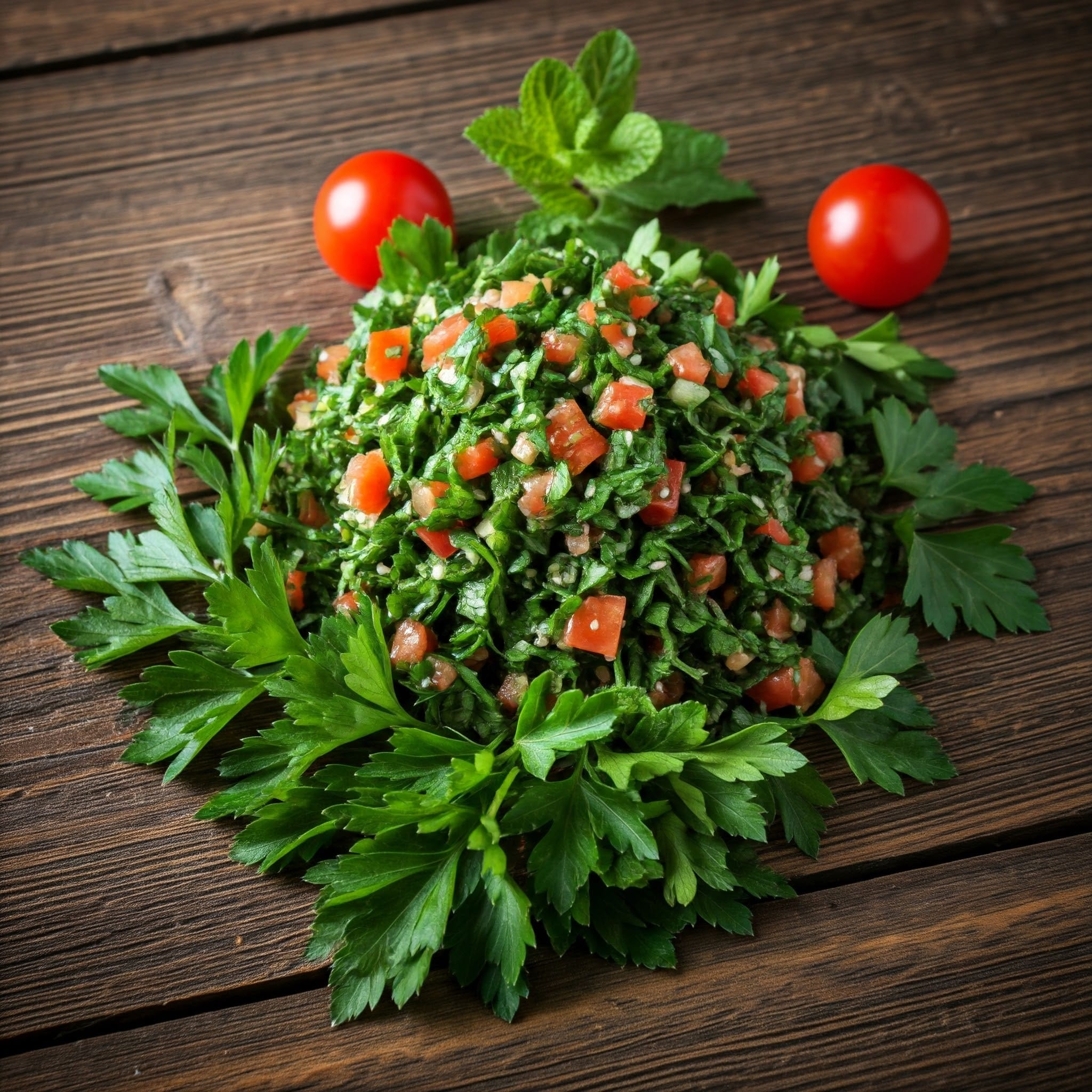
Tabbouleh
Tabbouleh or Tabouli Salad is a refreshing salad loaded with healthy herbs and veggies, primarily from Lebanon and Syria in the Middle Eastern region. It’s predominantly made with finely chopped parsley, mint, tomatoes, onions, soaked bulgur or couscous, seasoned with lemon juice, olive oil, and spices.
Dark green parsley, the hero of this salad, is not just a garnish but is full of health benefits. It’s a rich source of vitamins A, C, and K, as well as folate, and it has a high chlorophyll content that may help control bacterial growth in the body. The fresh mint leaves not only add a cooling refreshment but also aid digestion. Tomatoes lend a burst of juicy freshness, while the onions provide a slight crunch. Bulgur or couscous provides a wholesome, grainy touch, boosting the satiety of the salad and making it more filling.
Commonly served as part of a mezze (appetiser) plate, Tabbouleh is relished with pita bread or crispy lettuce leaves. A common variation of Tabbouleh in Turkey includes the addition of pomegranate molasses, giving it a sweet-tart flavour profile. The tangy lemon and olive oil dressing is simple yet adds zest to this vibrant salad, encompassing the spirit of Mediterranean cuisine.
Recipe
- Rinse ½ cup bulgur and soak it in boiling water for 15 minutes until tender, then drain.
- Finely chop 2 bunches of parsley, a handful of mint, 2 tomatoes, and 1 small onion.
- Mix the bulgur with the chopped vegetables.
- Drizzle with 3 tbsp olive oil and 2 tbsp lemon juice, and season with salt and pepper.
- Toss well and refrigerate for an hour before serving.
3. Moussaka
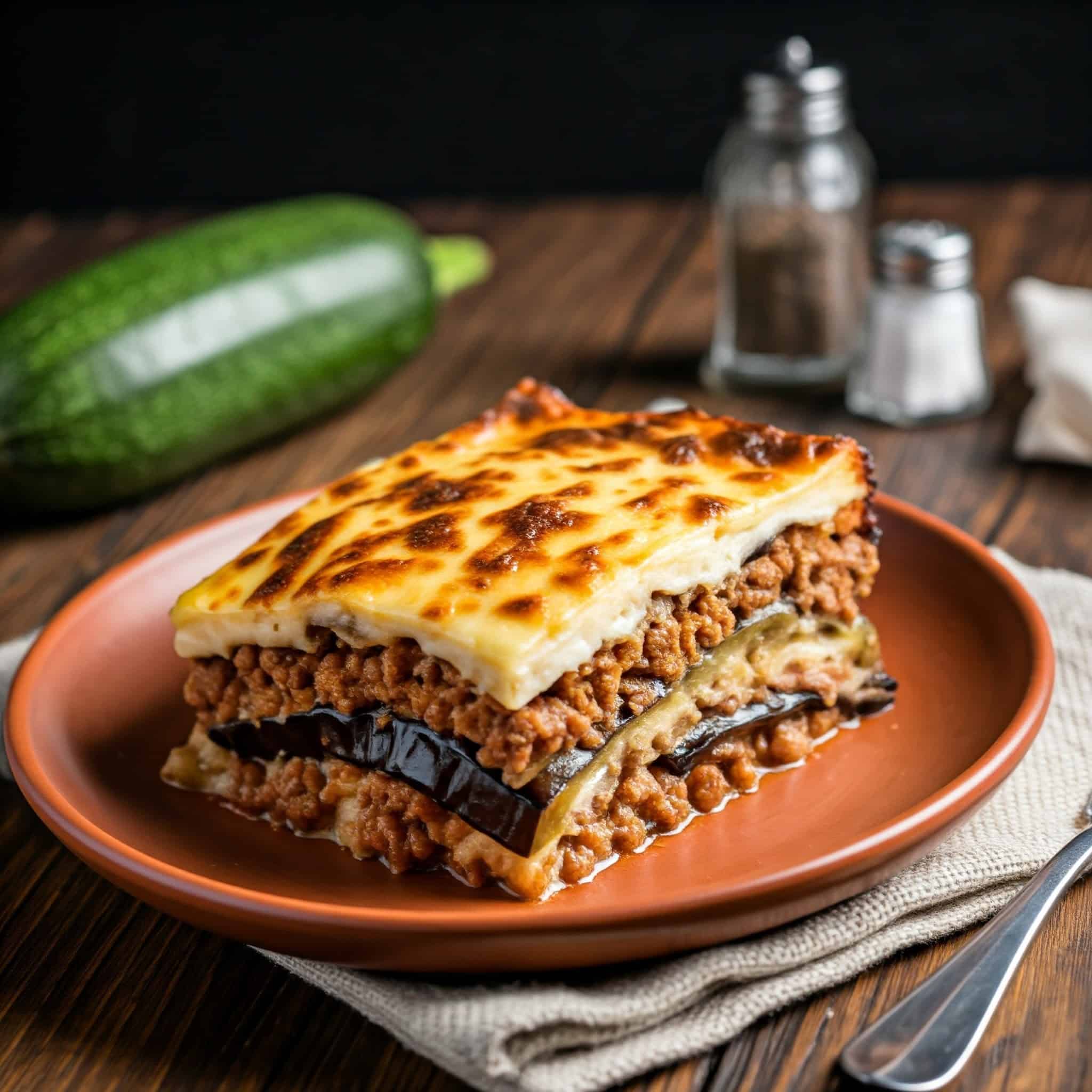
A graphic illustration of Moussaka
Moussaka is a traditional Greek comfort food hailed as the Mediterranean version of Lasagna. Though variations of this dish span across the Balkans, Middle East, and Eastern Europe, the most globally renowned version is Greece’s layered eggplant Moussaka. This rich, hearty casserole consists of sautéed eggplant, minced meat, tomatoes, onions, and spices interlayered and topped with a creamy béchamel sauce and cheese.
Brimming with layers of flavour, Moussaka is an optimistic example of Mediterranean cuisine. It heavily centres on eggplant, a staple in the Mediterranean diet celebrated for its meat-like texture and capacity to absorb other flavourings. Ground meat, traditionally lamb, can be substituted with other meats or lentils as a vegetarian option. The sweet tomatoes and onions balance the meaty components of this dish, crowned with the unctuous béchamel sauce that creates a beautifully golden, irresistible crust upon baking.
Recipe
- Slice 2 large eggplants, brush with olive oil and roast or pan-fry until golden.
- In a skillet, sauté 1 diced onion and 2 minced garlic cloves in olive oil. Add 500g ground beef or lamb, cooking until browned.
- Stir in 1 can of crushed tomatoes, 1 tsp cinnamon, and salt and pepper. Simmer for 15 minutes.
- Prepare a béchamel sauce by melting 2 tbsp butter, whisking in 2 tbsp flour, and gradually adding 2 cups milk. Cook until thickened, then add salt, pepper, and a pinch of nutmeg.
- Layer eggplant slices, meat sauce, and béchamel in a baking dish, repeating layers.
- Top with grated cheese and bake at 180°C (350°F) for 30-40 minutes until golden brown.
4. Shakshuka
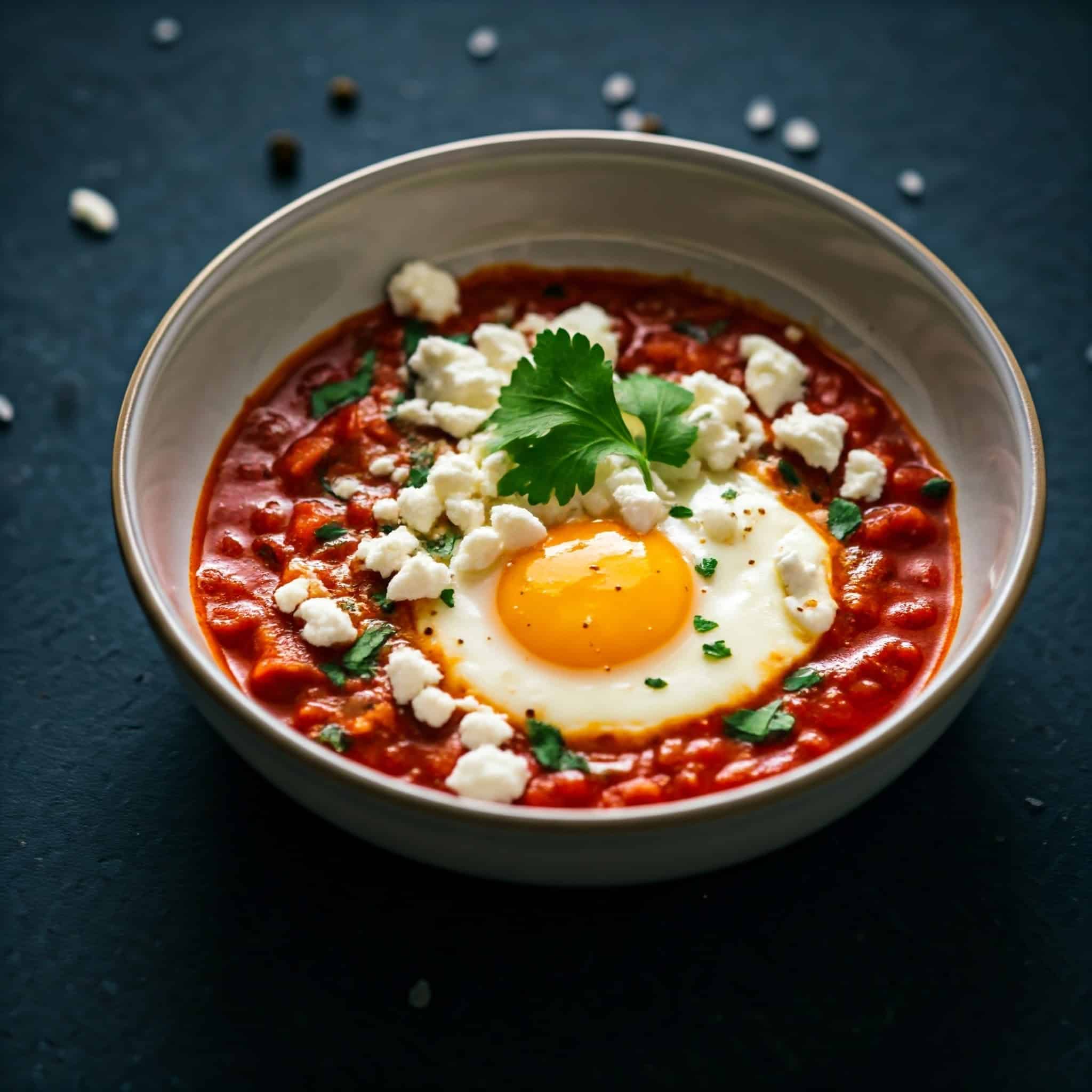
Shakshuka
Shakshuka, hailing from North Africa, specifically Tunisia, is a beloved breakfast/brunch dish across Israel and other eastern Mediterranean countries. Essentially, it’s a one-pan dish of eggs poached in a fragrant tomato-based sauce spiced with cumin, paprika, and cayenne, often garnished with fresh herbs like parsley or cilantro.
The star ingredient, eggs, are an excellent source of high-quality protein and various vitamins and minerals, featuring the show-stopping runny yolks that ooze creamy richness. Immersed in a sea of a mildly spicy, tangy tomato stalactite sauce imbued with warm spices, these eggs undergo a delightful transformation. The vegetables – bell peppers and onions – further add to the flavour matrix.
Keeping true to its roots, Shakshuka is typically scooped up with pita bread or any style of crusty bread, making it a harmonious balance of carbs, protein, and fats. Although it’s associated with breakfast, Shakshuka makes a satisfying, quick dinner when the appetite leans toward eggs.
Recipe
- Heat 2 tbsp olive oil in a skillet. Sauté 1 diced onion, 1 bell pepper, and 2 minced garlic cloves until soft.
- Stir in 1 can of diced tomatoes, 1 tsp paprika, 1 tsp cumin, ½ tsp chilli powder, and salt and pepper. Simmer for 10 minutes.
- Make small wells in the sauce and crack in 4-6 eggs. Cover and cook until the egg whites are set but the yolks are still runny.
- Garnish with chopped parsley or cilantro and serve with crusty bread.
5. Falafel
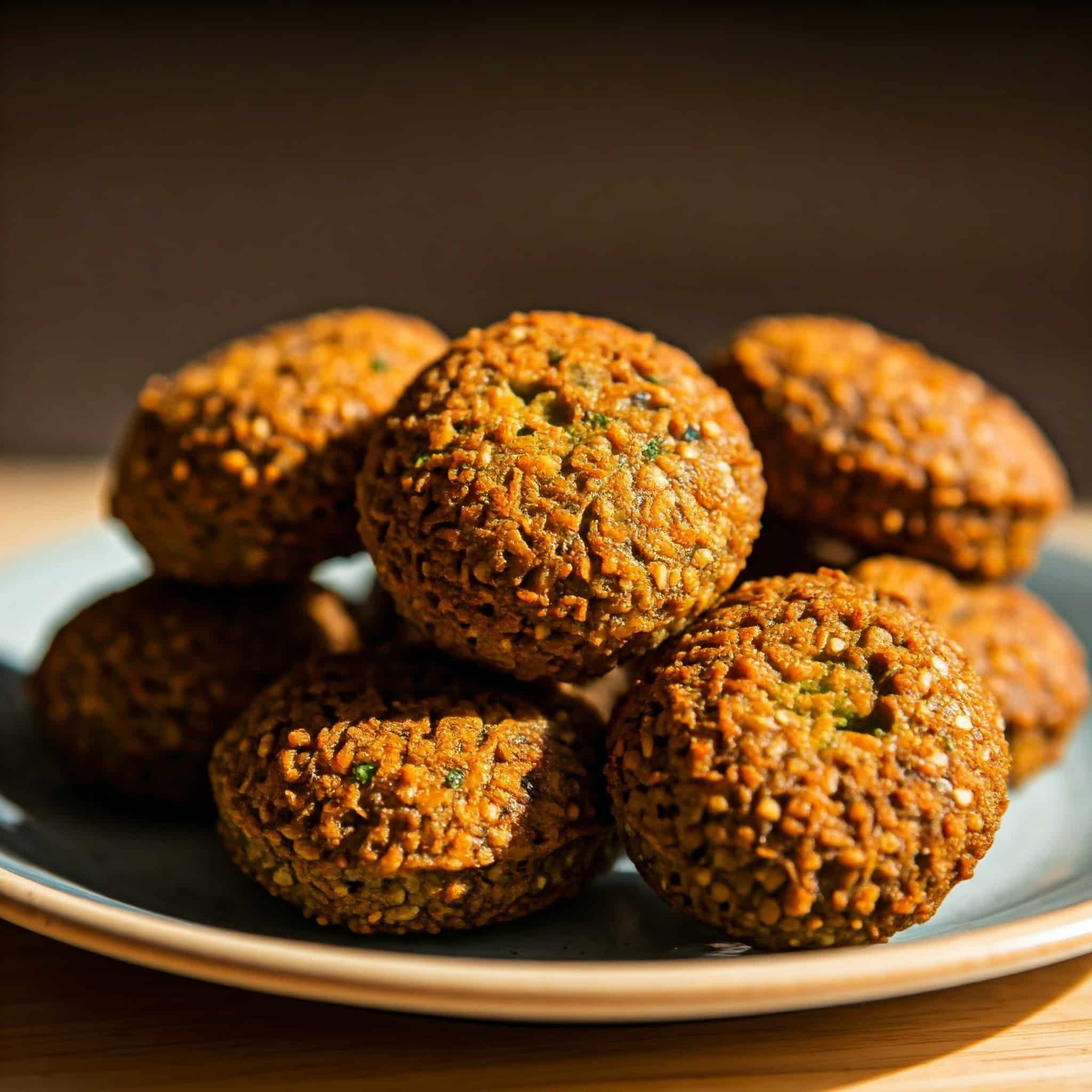
Falafel
Falafel, the Middle Eastern classic, has turned into a global sensation adored by vegans, vegetarians, and meat-eaters alike. These crispy, nutty balls or patties are made largely from chickpeas (or fava beans in Egypt), fresh herbs, onion, and a unique blend of Middle Eastern spices.
Traditionally deep-fried to perfection, these golden nuggets are crispy on the outside while maintaining a tender, moist interior. The primary ingredient, chickpeas, offers ample protein, fibre, vitamins, and minerals. Paired with antioxidant-rich herbs like parsley and coriander, it imparts a lively green hue to the Falafel insides, making this a nutrient-dense snack or meal addition.
Usually enjoyed stuffed inside pita bread with a selection of salads, pickles, and tahini sauce, it’s also popularly served as part of a mezze platter. Baked or air-fried versions provide a lighter alternative without sacrificing the distinct taste or texture. Falafel is a true testament to the creativity of Mediterranean culinary arts, turning plant-based ingredients into a delicious, nutritionally dense, and satisfying dish savoured worldwide.
Recipe
- Soak 1 cup of dried chickpeas overnight and drain.
- Blend chickpeas with 1 small onion, 3 garlic cloves, a handful of parsley, 2 tsp cumin, 1 tsp coriander, ½ tsp cayenne, 1 tsp baking powder, and salt and pepper until a coarse mixture forms.
- Shape into small balls or patties and refrigerate for 30 minutes.
- Deep fry or bake at 200°C (400°F) until golden and crispy.
- Serve with tahini sauce or pita bread.
6. Spanakopita
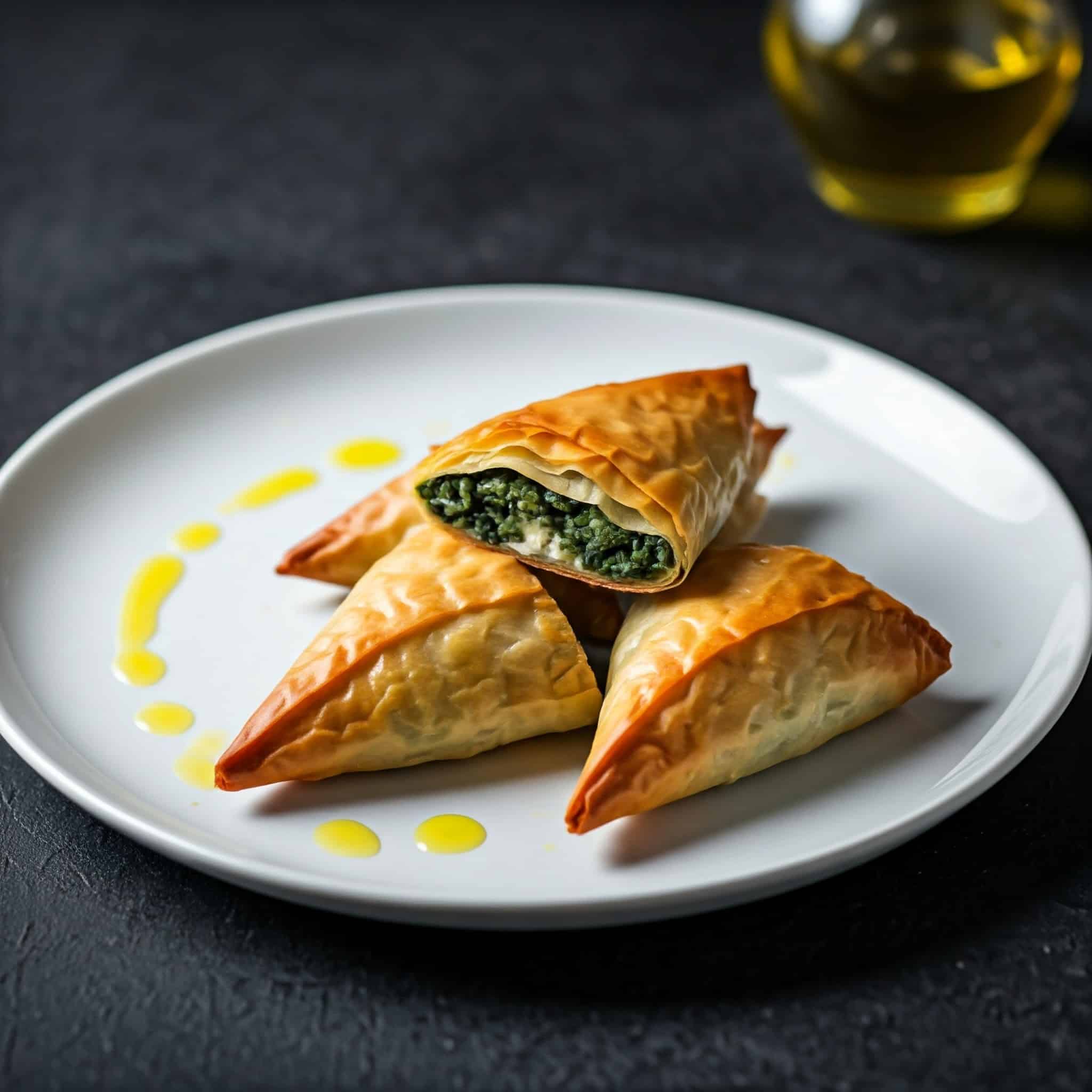
A graphic illustration of Spanakopita
Spanakopita, a traditional Greek savoury pastry, evokes the elements of simplicity and richness inherent to Mediterranean cuisine. This flaky, golden treat is typically made from layers of buttered phyllo dough filled with a hearty mix of spinach, feta cheese, onions, and eggs, all seasoned with fresh herbs.
The hero ingredient, spinach, is a powerhouse of nutrients, supplying a significant amount of Vitamin A, C, E, and K, as well as iron and calcium. When combined with the tangy feta cheese and a hint of dill, spinach creates a nourishing and flavour-packed filling which contrasts perfectly with its buttery, crunchy phyllo exterior. Traditionally served as a popular snack or appetiser at Greek celebratory events, Spanakopita also makes a fantastic lunch when paired with a simple salad. It’s perfect for any occasion- as a finger food at parties or a light, satisfying dinner shared in the family.
While it’s often made as individual triangles, Spanakopita can also be baked as a whole pie and sliced into serving pieces, highlighting the flexibility of this classic dish. There are numerous variations, with other vegetables, cheeses, or herbs added to the filling to give a twist on the original. Incorporating delicious taste, nutritional value, and versatility, Spanakopita exemplifies the beauty of Mediterranean cuisine – turning humble ingredients into a sophisticated, crowd-pleasing delight.
Recipe
- Sauté 1 diced onion and 2 minced garlic cloves in olive oil. Add 500g chopped spinach and cook until wilted. Cool slightly.
- Mix the spinach with 200g crumbled feta, 2 beaten eggs, and a pinch of nutmeg. Season with salt and pepper.
- Brush a baking dish with butter and layer 6 sheets of phyllo dough, brushing each with melted butter.
- Spread the spinach mixture evenly and top with another 6 layers of phyllo, brushing butter between each layer.
- Score into squares and bake at 180°C (350°F) for 25-30 minutes until golden and crispy.
7. Ratatouille
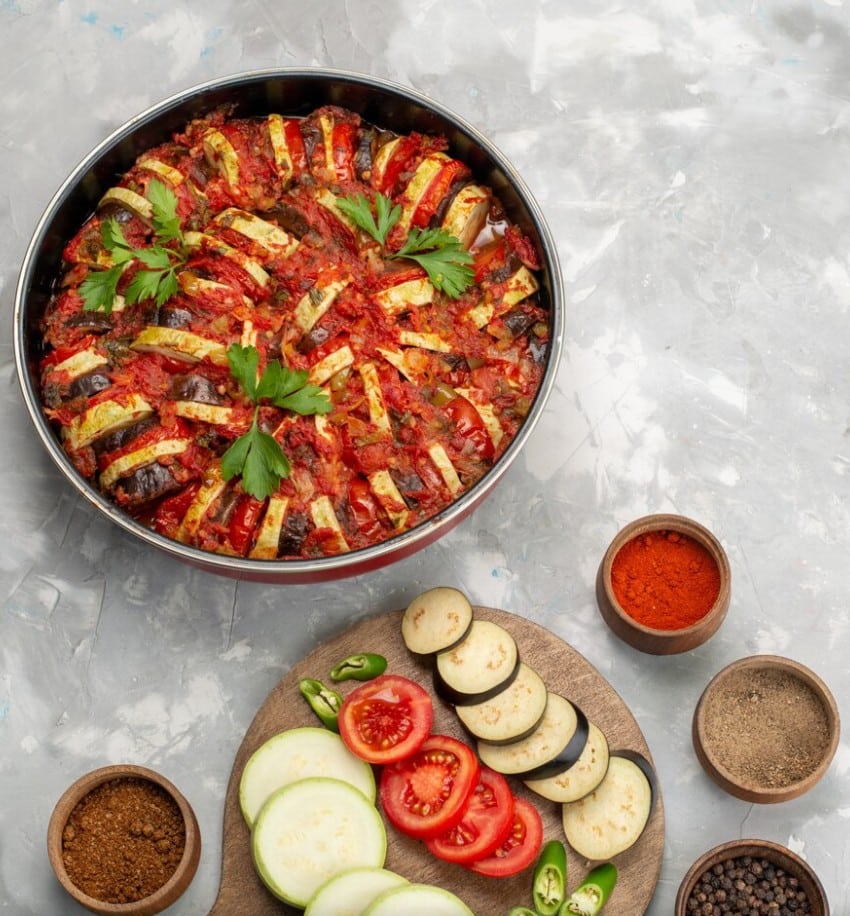
ratatouille
Ratatouille, a rustic French vegetable stew, simultaneously embodies the essence of Provencal cooking and the philosophy of the Mediterranean diet. Bursting with a rainbow of summer produce like fresh bell peppers, tomatoes, eggplants, and zucchinis seasoned with fragrant herbs, this comforting dish paints an alluring picture of Mediterranean cuisine’s love affair with vegetables.
Each spoonful of Ratatouille brings a robust taste achieved through slow cooking that enhances the vegetables’ inherently sweet flavours and the herbs’ infused oils. This warmth-packed dish, robust yet light, reflects the soul of Mediterranean cooking in its celebration of natural flavours, making healthy eating an enjoyable experience.
Recipe
- Preheat oven to 190°C (375°F).
- Thinly slice zucchini, eggplant, tomatoes, and yellow squash into equal-sized rounds.
- Spread a layer of tomato sauce made with sautéed onions, garlic, crushed tomatoes, olive oil, salt, and pepper in the bottom of a baking dish.
- Arrange the vegetable slices in a circular pattern, alternating zucchini, eggplant, tomato, and squash.
- Drizzle with olive oil, sprinkle with salt, pepper, and fresh thyme leaves. Cover with foil and bake for 40 minutes.
- Remove the foil and bake for an additional 10 minutes to lightly brown the top. Serve warm or at room temperature.
8. Baklava

A graphic illustration of Baklava
Baklava, the quintessentially Eastern Mediterranean dessert, offers the ultimate sweet finish to any meal. Delectably crafted from layers of thin, crisp phyllo pastry filled with a spiced nut mixture – typically walnuts, pistachios, or almonds – and slathered in sweet syrup or honey, Baklava embodies the decadence of Mediterranean sweets.
This luxurious pastry has deep roots in the former Ottoman Empire, claiming origin from the cuisines of modern-day Turkey, Greece, and the Middle East. While variations exist across these cultures, they all share the principal elements – phyllo, nuts, and syrup or honey, proving the interconnectedness of Mediterranean food.
Baklava serves up pure satisfaction. The crisp, buttery phyllo, warmly spiced, crunchy nuts, and sticky sweetness work in harmony to create a rich sensory experience. Usually enjoyed in small bites due to its richness, it’s the ideal accompaniment to tea or coffee, allowing you to linger over its delightful complexities.
Recipe
- Preheat oven to 175°C (350°F).
- Brush a baking dish with melted butter. Layer 8 sheets of phyllo dough, brushing butter between each layer.
- Spread a mixture of finely chopped walnuts, cinnamon, and sugar over the top.
- Add 8 more phyllo layers, brushing with butter between each.
- Cut into diamond shapes and bake for 30-35 minutes.
- Pour a hot syrup made of honey, sugar, and water (boiled for 5 minutes) over the baklava as soon as it comes out of the oven. Let it cool before serving.
9. Baba Ganoush
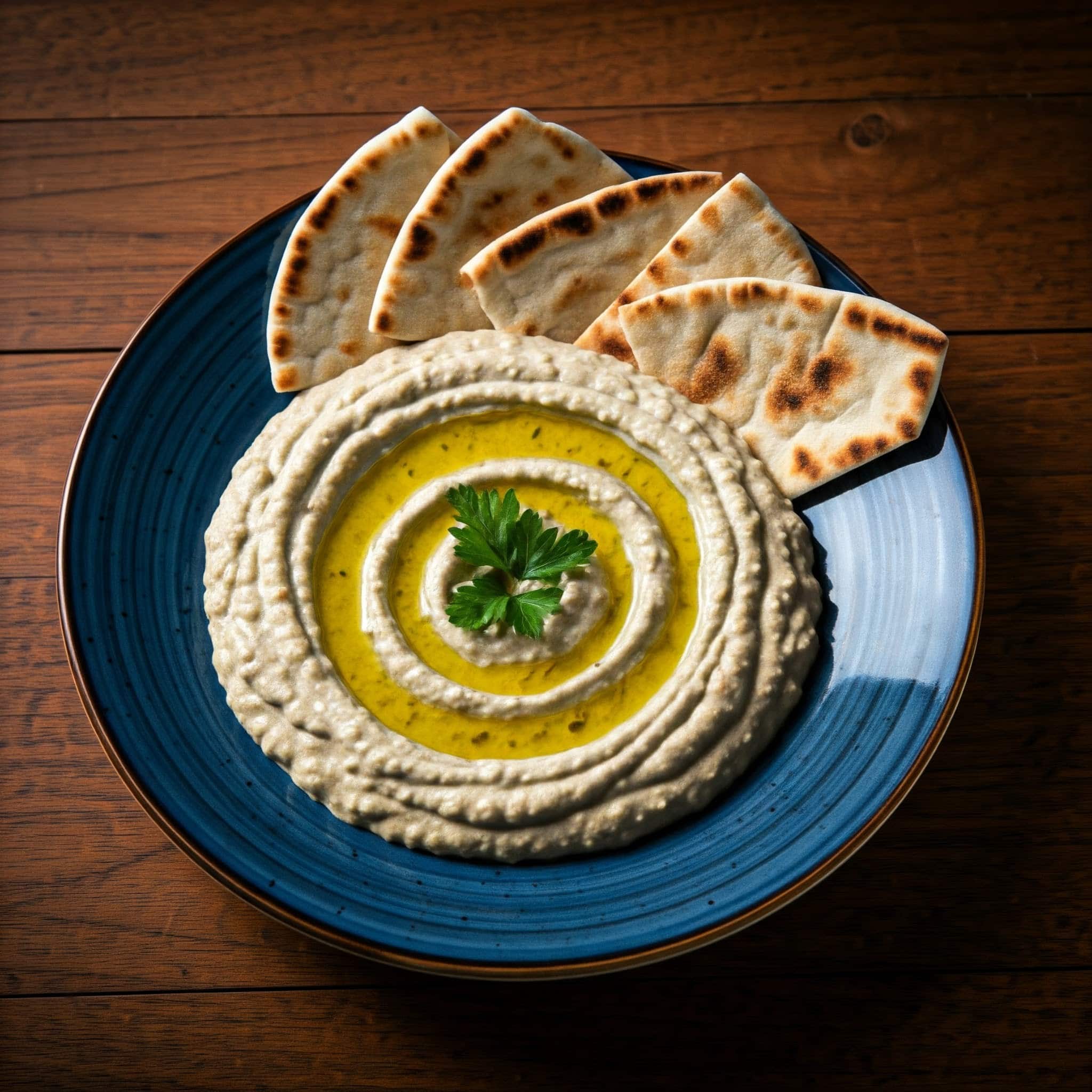
Baba Ganoush
Hailing from the Levantine region, Baba Ganoush is a creamy, smoky eggplant dip with a tangy accent that has become a favourite worldwide. This appetiser forms an integral part of Middle Eastern cuisine and various vegan and vegetarian diets.
The name Baba Ganoush translates roughly from Arabic as ‘pampered papa’ or ‘coy daddy,’ possibly hinting at the affectionate, indulgent nature of this dish. The leading player in Baba Ganoush, eggplant, is a low-calorie vegetable rich in dietary fibre that supports a healthy digestive system. When smoked over an open flame until soft and charred, it extracts an irresistible, smoky depth that mingles delightfully with creamy tahini, fresh lemon juice, garlic, and a mix of earthy spices.
Serve Baba Ganoush as a starter alongside pita bread or sliced vegetables to scoop up the delectable spread. At the same time, it can also be incorporated as a sandwich filling or as a garnish for cooked meats and vegetables. Displaying humble ingredients transformed into a flavorful, internationally loved dish, Baba Ganoush epitomises the essence of Mediterranean cooking.
Recipe
- Roast 2 large eggplants directly over an open flame or in the oven until the skin is charred and the flesh is soft.
- Cool, peel off the skin, and mash the flesh in a bowl.
- Mix the mashed eggplant with 3 tbsp tahini, 2 tbsp lemon juice, 2 minced garlic cloves, and 2 tbsp olive oil.
- Season with salt and a pinch of smoked paprika.
- Garnish with olive oil and parsley before serving.
10. Souvlaki
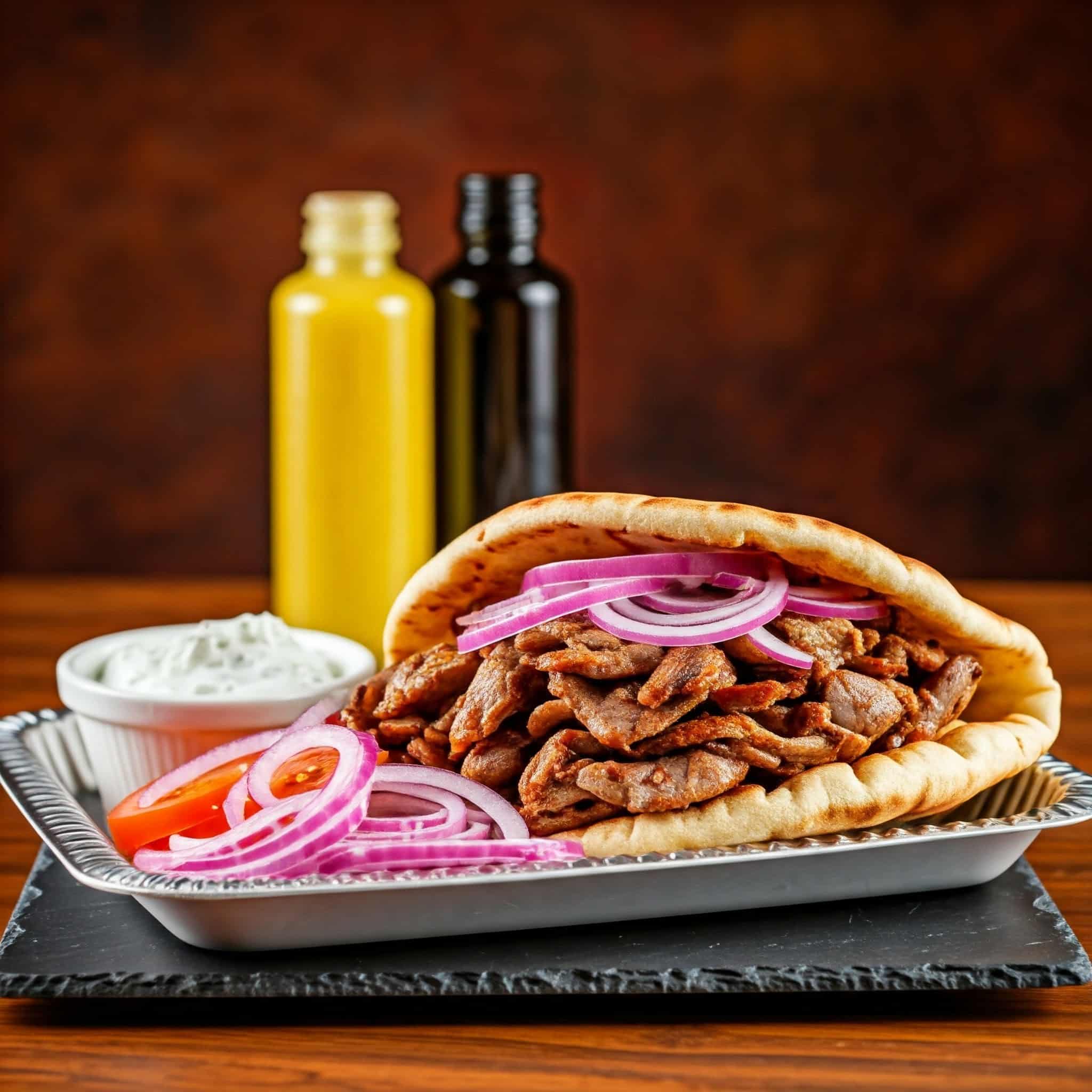
A graphic illustration of Souvlaki
Originating in Greece, Souvlaki plays an iconic role in Mediterranean fast food. Skewers of succulent, marinated pieces of meat – usually pork or chicken – are grilled to perfection and paired typically with fresh tzatziki sauce, presenting a feast of dynamic flavours. The star, in this case, is the meat, tenderised by marinating using olive oil, lemon juice, garlic, and Mediterranean herbs such as oregano. This process not only enhances the flavour but also ensures that the Souvlaki is moist and juicy after grilling.
Souvlaki is often enjoyed on the go, served in pita bread wraps with an array of garnishes like fresh tomatoes, onions, lettuce, and a generous smear of tangy tzatziki sauce. In sit-down meals, it’s commonly served with a side of Greek salad, roasted vegetables, or French fries. This skewered meat dish is not just palate-pleasing but also quick, portable and can quickly pull together a variety of meals. These attributes have propelled its popularity in street food scenes across the Mediterranean and throughout the world.
Southern Europe’s take on the kebab is a testament to the convening power of food that evokes communal joy and embodies the heart of Mediterranean cuisine with versatile brilliance seen across diverse cultures of the vast basin.
Recipe
- Cut 500g of pork, chicken, or lamb into bite-sized cubes and place in a bowl.
- Marinate the meat with 3 tbsp olive oil, 2 tbsp lemon juice, 2 minced garlic cloves, 1 tsp oregano, 1 tsp paprika, and salt and pepper. Cover and refrigerate for at least 1 hour.
- Thread the marinated meat onto skewers.
- Grill the skewers over medium-high heat, turning occasionally, for 8-10 minutes until the meat is cooked through and slightly charred.
- Serve with warm pita bread, tzatziki sauce, and a side of fresh salad or roasted vegetables.
Conclusion
Mediterranean cuisine is a celebration of vibrant flavours, wholesome ingredients, and rich culinary traditions that have stood the test of time. From the creamy indulgence of hummus to the smoky allure of moussaka, these 10 must-try dishes offer a delightful journey through the Mediterranean’s diverse food culture. Whether you’re savouring fresh seafood, aromatic spices, or hearty grains, each bite tells a story of the region’s heritage and love for good food. So, gather your appetite and start exploring these dishes—you might just discover your next favourite meal! Check out more such dishes and cuisines at Awesomecuisine.
Frequently Asked Questions
What is Mediterranean cuisine?
Mediterranean cuisine is a diverse culinary tradition originating from the regions surrounding the Mediterranean Sea. Known for its emphasis on fresh fruits, vegetables, whole grains, lean proteins, and especially extra virgin olive oil, it’s celebrated globally for promoting healthful and sustainable living.
What is the difference between Mediterranean cuisine and Middle Eastern cuisine?
While both cuisines share key ingredients and dishes, Mediterranean cuisine encompasses a larger geographical area, including Southern Europe and North Africa, offering more culinary diversity. Middle Eastern cuisine, on the other hand, is defined by flavours and techniques specific to countries like Lebanon, Syria, and Turkey.
Why is Mediterranean cuisine considered healthy?
Mediterranean cuisine is praised for its high concentration of antioxidants, fibre, and healthy fats, primarily derived from laden whole grains, fruits, vegetables, lean proteins, and notably, olive oil. Its balanced focus on nutrient-dense, whole foods leads to numerous health benefits, making it a healthful choice.
How can I incorporate Mediterranean cuisine into my daily diet?
Including Mediterranean dishes in your diet can be as simple as swapping your usual cooking oil with extra virgin olive oil, increasing your intake of fruits, vegetables and whole grains, using herbs and spices for flavour, and prioritising fish and poultry over red meat.
What are some tips for cooking Mediterranean dishes at home?
Use fresh, quality ingredients, lean more on plant-based foods, and incorporate abundant herbs and spices for seasoning. Embrace olive oil as your primary fat source and use it generously. Also, enjoy meals with friends and family – as Mediterranean cuisine is not just about food, but also companionship.

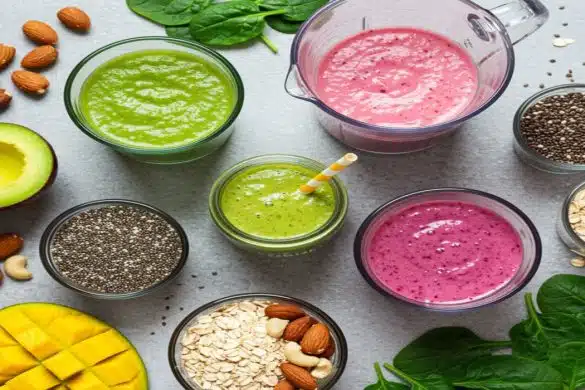








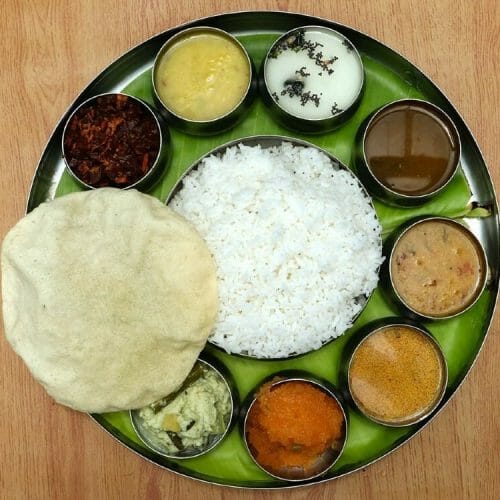
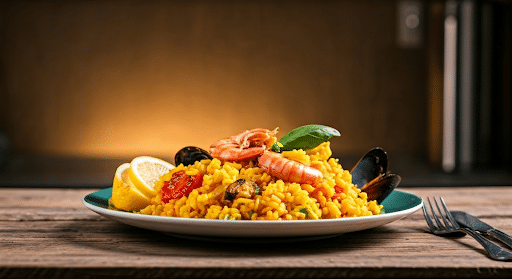
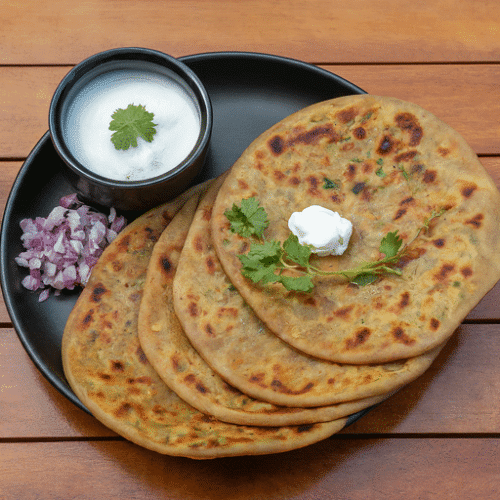

2 comments
Incredibly you have not included the outstanding food of Spain ( rich in taste &nutrition – can you possibly omit
Paella or Tortilla Ala Espanola or Gazpacho? to name a few of the many many delicious dishes)?
Hi,
Spanish cuisine is rich and diverse. We have a separate blog post coming just on the foods of Spain 🙂